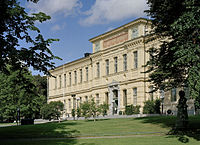- National Library of Sweden
-
Kungliga biblioteket English National Library of Sweden 
Country Sweden Established 1661 Reference to legal mandate The Government Approval Document for The Swedish National Library (available in Swedish Location Stockholm Coordinates 59°20′17″N 18°04′19.75″E / 59.33806°N 18.0721528°ECoordinates: 59°20′17″N 18°04′19.75″E / 59.33806°N 18.0721528°E Branches 2 (Department of Audiovisual Material, Roggebiblioteket) Collection Items collected books, journals, newspapers, magazines, films,recorded sound, television, radio, manuscripts, maps, pictures, printed music, ephemera and digital resources Size Circa 25 M and 7 M hours of audiovisual material Criteria for collection Suecana: publications published, broadcast or recorded in Sweden or by Swedish originator or concerning Sweden Legal deposit Yes, and agreements with publishers Access and use Access requirements Free. Registration for loans: be Swedish resident or citizen over 18. (Audiovisual may only be accessed for research purposes) Circulation 135, 187 (2009) Other information Budget 311 M Swedish crowns (2009) Director Dr. Gunnar Sahlin Ph.D. (since 2003) Staff 420 Website Official website in English Phone number +46 (0) 8 463 40 00. The National Library of Sweden (Swedish: Kungliga biblioteket, KB, meaning "the Royal Library") is the national library of Sweden. As such it collects and preserves all domestic printed and audio-visual materials in Swedish, as well as content with Swedish association published abroad. Being a research library, it also has major collections of literature in other languages.
Contents
Collections
The Collections consist of more than 20 million objects. They contain, apart from books, posters, pictures, manuscripts, newspapers and much more. The audio-viusal collection consists of more than 7 million hours of recorded material.
The National Library is also a humanities research library with collections of foreign literature in a wide range of subjects including archeology, history, literature studies, and art history.
The National Library also purchases literature about Sweden written in foreign languages and works by Swedes published abroad, a category known as suecana. The National Library has been collecting floppy disks, CR-Rs, and other electronic storage media since the mid 1990s, along with e-books, e-journals, websites, and other digital material
In 1953, the National Library purchased considerable amounts of Russian literature from Leningrad and Moscow. These books were to form the basis of a Slavonic library in Stockholm. These plans were consolidated in an agreement made in 1964 between the Lenin Library in Moscow and the National Library in which the respective libraries agreed to exchange their countries' literature.
Legal Deposit
According to the Swedish Legal Deposit Act publishers of printed material must send one copy of every object to the National Library and six other research libraries. Publishers of music, film, radio and TV must similarly submit copies to the library. In some cases only a sample of broadcast material has to be submitted.
The obligation to collect all printed works in Swedish was laid down in 1661 in an ordinance from the Swedish Privy Council Chancery. The ordinance (legal deposit) ordered all printers in Sweden to send two copies of every publication printed to the Chancery before the material was distributed. One copy was to go to the Swedish National Archives (Riksarkivet), the other to the National Library. The motive for this provision stemmed not from a desire to preserve publications for posterity but from a desire to monitor their contents.
Library cooperation
The National Library is responsible for supplying information to higher education and research, which includes obtaining central license agreements for research and university libraries to increase access to various databases.
The National Library maintains and develops LIBRIS, the national library database system. LIBRIS is freely available to the public via the Internet and contains more than five million titles held in 300 Swedish libraries.
The Swedish ISBN Agency is a unit within the Royal Library, responsible for assigning ISBNs having the country prefix 91- (and 978-91-) for Sweden.
Visits
Anyone may use National Library services, but people must be at least 18 to request and order materials from the collections. Items in the Swedish collection cannot be borrowed for home use and must be read in one of the reading rooms.
The National Library is located in Humlegården in central Stockholm. The correct written form of the name is “The National Library of Sweden” or in Swedish, "Kungl. biblioteket".
History
The roots of what we now know as the National Library go back to the days of King Gustav Vasa in the 16th century. The king collected books on a variety of subjects including history, science, and theology, as well as maps. The collections were expanded by Eric XIV, Johan III, and Charles IX and kept in the Royal Palace known as Tre Kronor (The Three Crowns). Some books were purchased abroad and others were confiscated from Swedish monasteries dissolved in the Reformation. King Gustavus Adolphus gave away parts of the royal book collection in 1620 and those books were the foundation of the Uppsala University Library.
The collection was also expanded through spoils of war taken during the Thirty Years War. These captured treasures included the episcopal library of Würzburg in 1631, the University of Olomouc library in 1642, and the royal library of Prague in 1649. It was in this connection that the 13th century “Devil's Bible” (the Codex Gigas) came to Stockholm. Queen Christina took much of this material with her to Rome after she abdicated the Swedish throne, but the royal collections continued to grow during the reign of Charles X Gustav through additional spoils of war and purchases abroad. The manuscript collection also includes the Stockholm Codex Aureus.
Under the Chancery Decree of 1661, all book printers in Sweden were required by law to submit two copies of everything they printed – one copy for the National Archives and the other for the National Library. Rather than to acquire newly published literature for research purposes, the decree reflected the desire of a great power to exert state control and censorship.
Much of the library went up in flames during the great palace fire of 1697 when 17,286 bound volumes and 1,103 manuscripts were lost. Only 6,700 volumes and 283 manuscripts survived. Thereafter, the books were stored temporarily in various noble palaces in Stockholm, first in Count Lillie’s house on what was then Norrmalm Square (1697–1702), and later in the Bonde Palace (1702–1730), and Count Per Brahe’s house on Helgeandsholmen (1730–1768). Finally, in 1768, the collections could be moved into the northeast wing of the new royal palace.
The collection grew further in its new home when the Antiquities Archive was dissolved in 1780 and most of the books kept there were transferred to the National Library. In 1792, Gustav III donated his private library of 14,500 works and four years later, Gustav IV Adolf donated 7,500 works. As a result, the National Library owned about 40,000 works by 1814.
Several large book collections, either donated or purchased, came to the National Library in the 19th century. Space was limited in the palace and a new home for the collections was required. In 1877, the National Library moved into new, dedicated premises in Humlegården. The library began installing electric lighting in 1887, but the library was not fully electrified until 1964.
The building
At first, the royal book collections were kept in the Royal Palace (Tre Kronor), which burned down in 1697. The National Library moved into its current building in Humlegården in December/January 1877/1878. The building was designed by Gustaf Dahl and built in the innovative cast iron technique. The two wings were added in 1926-27.
The National Library was reopened in spring 1997 after comprehensive remodeling and additions. Two large underground stacks were built into the bedrock now contain the bulk of the library's collections, while library patrons, other visitors, and employees share the space in the main building.
The new section, called the Annex, contains auditoriums, exhibition rooms, and a microfilm reading room. All Swedish daily newspapers and a large number of foreign newspapers are available on microfilm in the Microfilm Reading Room.
Organization
The National Library is a state agency that reports to the Ministry of Education and Research. Gunnar Sahlin has been the National Librarian of Sweden since 2003.
Since January 1:st 2009 the former Swedish National Archive of Recorded Sound and Moving Images has been merged with the National Library.
Digital collections
Since 24 March 1997, the National Library also archives the Swedish part of the World Wide Web as part of a project called kulturarw3 (a play on words; kulturarv is Swedish for cultural heritage). Initially, the contents were not available to the public due to copyright issues, but as of 2004[update] visitors to the library can access the archive from dedicated read-only computers on library premises. The project was discontinued in early 2010.
The library is also engaged in the automated collection of electronic resources including e-books and digital print editions from publishers of newspapers and periodicals. An extensive project to digitize physical material at risk of destruction is also in progress.
External links
- National Library of Sweden, official site in English
- Kulturarw3, description of the Kulturarw3 project
- LIBRIS English version of the site
- Swedish Media Database (SMDB)
National libraries of Europe Sovereign
states- Albania
- Andorra
- Armenia
- Austria
- Azerbaijan
- Belarus
- Belgium
- Bosnia and Herzegovina
- Bulgaria
- Croatia
- Cyprus
- Czech Republic
- Denmark
- Estonia
- Finland
- France
- Georgia
- Germany
- Greece
- Hungary
- Iceland
- Ireland
- Italy
- Kazakhstan
- Latvia
- Liechtenstein
- Lithuania
- Luxembourg
- Macedonia
- Malta
- Moldova
- Monaco
- Montenegro
- Netherlands
- Norway
- Poland
- Portugal
- Romania
- Russia
- San Marino
- Serbia
- Slovakia
- Slovenia
- Spain
- Sweden
- Switzerland
- Turkey
- Ukraine
- United Kingdom
- (England
- Northern Ireland
- Scotland
- Wales)
States with limited
recognition- Abkhazia
- Kosovo
- Nagorno-Karabakh
- Northern Cyprus
- South Ossetia
- Transnistria
Dependencies
and other territories- Åland
- Faroe Islands
- Gibraltar
- Guernsey
- Jan Mayen
- Jersey
- Isle of Man
- Svalbard
Other entities Categories:- Libraries in Sweden
- National libraries
- Culture in Stockholm
- Education in Stockholm
- Buildings and structures in Stockholm
- Government agencies of Sweden
- 1661 establishments
- Buildings and structures completed in 1878
- ISBN agencies
- World Digital Library
- Geographic region-oriented digital libraries
Wikimedia Foundation. 2010.

